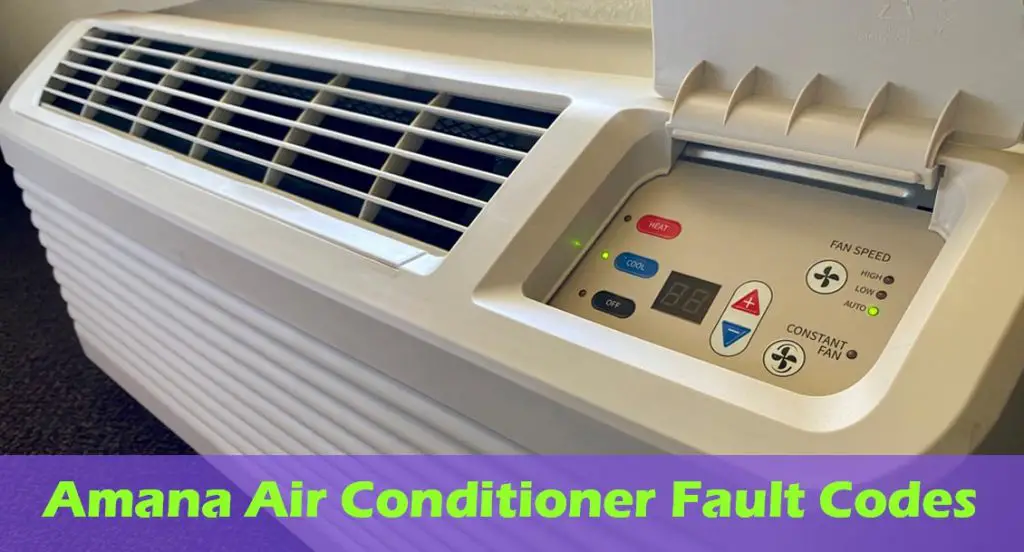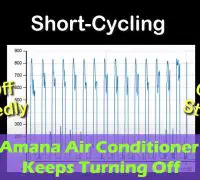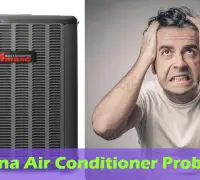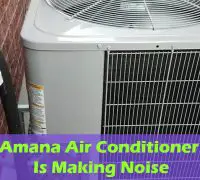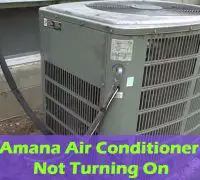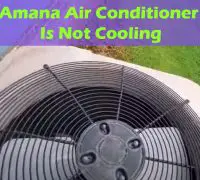Air conditioners, like all other pieces of HVAC technology, will develop maintenance problems occasionally. The Amana air conditioners are reliable and durable, but that doesn’t mean they will never encounter issues. No air conditioner is perfect—some have less risk of becoming faulty in time.
There are several troubleshooting steps you can take on to ensure proper operation for your Amana AC unit. Some problems have straightforward solutions, such as cleaning the coils or air filters, whereas others require more complex and professional attention. As with any reputed HVAC manufacturer, Amana air conditioners have a diagnostic function that helps you detect the problem through a system of codes.
Please keep reading to learn more about the diagnostic codes that your Amana air conditioner may display. We will also cover some of the most common fixes, troubleshooting steps, and tips for adequately operating your AC unit.
Page Table of Contents
Set the AC in the Diagnostic Mode
Your AC unit must be in the Diagnostic Mode to display error codes. It’s how the unit checks for errors and generates a code informing its operating state. Here’s how you can set your AC unit in diagnostic mode:
- Press and hold the Up (+) and Down (-) arrow buttons
- As you hold the arrows, press the COOL button twice.
If done right, the display will modify and your unit will turn to diagnostic mode. A red dot flashing in the corner of the display will inform of the proper setting of the unit. Next to the numbers informing temperature, you will notice a set of dashes (- -) or a diagnostic code. A green light (known as the “status light”) will show in the lower-left corner of the touchpad, below the Off button.
The Amana air conditioner fault codes
When there is no operational error failure, mode, or lockout, you will notice the dashes on display (- -), so no error code will show. Some maintenance issues may still be present, but the unit may not have a diagnostic code to inform of it. You will notice one of the codes below if the unit detects an error, operational failure, or lockout.
The system might display four codes for a maintenance problem: system modes, failures, airflow, and refrigeration alerts.
System modes
Amana air conditioning units come built-in with some system modes or operating states for safety, security, or compatibility functions. Each of them will show a specific code. The modes don’t necessarily relate to a maintenance problem but can make the unit operate improperly. Changing the settings or improving the unit’s surroundings are common fixes for the system modes:
FP – Freeze Protection
The FP code informs that the unit is in Freeze Protection mode. When the thermostat or thermistor identifies the temperature below 40F degrees, it activates the unit’s freeze protection mode. The mode will protect the essential components from freezing and causing damage. Once the thermostat or thermistor detects a temperature over 43F degrees, the unit will come out of the Freeze Protection mode.
Eo – Service Board Not Configured
The Eo code informs that the service board on the unit is not set correctly. To address it, you have to modify the configuration settings in the unit’s menu. If the setting is C3, you have to switch it to C. This tip is valid only for AC units that also have electric heat. If the unit operates on heat pumps, switch the setting to H.
Fd – Front Desk Switch
An Fd code means that the front desk switch isn’t open. Therefore, every output for the unit is off. To manage the issue, you must re-open the switch so the unit returns to proper operation.
LS – Load Shedding Mode
When you see the LS code, your unit is in the Load Shedding mode. This means that the compressor and the electric heat are not on and the LS switch is closed. You have to re-open the LS switch of the unit to make it come out of the LS mode.
EH – Emergency Hydronic Mode
An EH code means the unit has turned into Emergency Hydronic mode. It also signals that the compressor is off and the EHF switch isn’t open. Re-open the emergency hydronic switch to make the unit come out of the EH mode.
Op / Np – Open Door or Window Lockout Mode
When the unit detects that a door or window is open in the room, it will send the op or np code. As a result, the unit will no longer run to save energy. You only need to close the door and window to restore proper operation.
On–Wired Thermostat Configuration
Should the unit is set to run with a wired thermostat and not a wireless one, you will notice the On code in the display. You will notice a configuration error when you try to use the unit with a wireless thermostat. Changing the configuration mode to the correct setting in the configuration menu will solve the problem.
HP – Heat Sentinel Mode
You will notice the HP code when the unit enters the Heat Sentinel mode. Like freeze protection mode, the Heat Sentinel mode reduces the unit’s overheating risk. It can also cause a cooling function as a protective measure. Once the temperature in the room or the unit is safe, the unit will come out of the HP mode independently.
Ur – Un-Rented Mode
The unit has the Un-Rented status when the code display is Ur. The feature stops the unit from the correct operation. To remove the unit from the Ur mode, you have to change its status from Un-rented to Rented.
Failure codes
When a unit component has become defective or failed, a failure code will show. Commonly, you will have to repair or replace defective components. Some codes will not detect malfunctions in all components, but they can still help identify some of the most common issues.
F1 – Thermistor and Thermostat Failure
Typically, the F1 code informs on a double failure. It informs that the indoor Ambient thermistor (black) reads outside the set range (-20 to 200F degrees), whereas the wireless thermostat no longer sends signals to the unit control. The black thermistor and /or the wireless thermostat will need replacing.
F2 – Wireless Remote Thermostat Failure
The code F2 informs a failed Wireless Remote Thermostat. Replacing the thermostat is the solution.
F3 – Indoor Ambient Thermistor (Black) Failure
Similar to F1, the F3 code informs that the black Indoor Ambient Thermistor reading on the unit is no longer within the set range (-20 and 200 F degrees). The solution is to replace the thermistor.
F4 – Indoor Coil Thermistor (Red) Failure
The F4 codes mean that the red indoor Coil Thermistor has failed or exceeded its operating tolerance. Replacing the thermistor is the fix.
F5 – Wireless Thermostat Failure
When the wireless thermostat has failed, the code F5 will show. To manage the problem, you must rebind or even replace the thermostat.
F6 – Indoor Discharge Thermistor (Yellow) Failure
A yellow Indoor Discharge Thermistor failure will lead to a code F6. The code means the thermistor has exceeded or is below its operating tolerance and needs replacing.
Fb – Low Remote Battery
When the battery in the unit remote is low, you will notice the Fb code. You need to replace the battery inside the device with a new one.
H1 – High Voltage Protection
A high input voltage will lead to an H1 code. You have to check out the voltage inside the unit and make the proper adjustments. High voltages will cause extreme shock and you must be extra cautious when examining the unit’s voltage. Contacting an electrician is the wise thing to do.
Br – Brown Out Protection
You will notice the Br code if the unit has lost power or the incoming voltage is low. You will have to verify the voltage coming to the unit and correct it to the correct levels. Stay on the safe side and hire an electrician for the job.
Airflow Alerts
Some of the codes on the unit will inform on airflow systems and temperatures. General maintenance on some parts (coils and filters) will be necessary. Here are the airflow-related problems that the unit can sense:
LC- Outdoor Coil Thermistor (Red) Heat Warning
If the red Outdoor Coil Thermistor reaches hot temperatures that aren’t safe for operation, the display will show an LC code. The condenser and the air filter may need cleaning. Additionally, you have to make sure that the condenser fan works accordingly.
L6 – Discharge Air Heat Warning
If the air from the unit is too hot for correct operation, there will be an L6 code. Cleaning the air filter should fix the problem.
C5 – Outdoor Coil Heat Warning
Code C5 informs that the outdoor coils’ temperatures are too high for outdoor ambient readings. You must clean the coils and remove what stops the outdoor air from flowing into the unit.
C2 – Indoor Air Recirculation
When the air inside the room is recirculated through the unit, you will notice the C2 code. The situation alters both the conditioning and the freshness. Examine the seal around the unit and ensure it forms a strong barrier between inside and outside air. This way, the airflow is conditioned through the unit. Closing the vent door and cleaning the filter may also be necessary.
Refrigeration Errors
The air conditioner may also identify problems from the refrigeration system and cooling temperatures. Some errors have easy fixes, whereas others require professional servicing.
C1, C3, and C4 – Indoor Coil Freeze Warning
When the unit displays C1, C3, or C4 codes, the indoor coil has started to freeze or is already frozen. You may clean the filter and look for defective parts in the fans or blowers to manage the issues. Examine the refrigerant levels as well and manage any leaks. Remember also to see if the capillary tube is blocked or not.
C6 – Improper Unit Performance
A C6 code informs that several parts of the unit malfunction or don’t run as efficiently as they should. You must check out the blower motor, the compressor, and the electric heat elements. Replacing and cleaning the parts might be necessary.
C7 – Indoor Freezing Lockout
Code C7 identifies freezing problems similar to C1, C3, and C4. Additionally, the code will lock the temperature settings and other proper operations of the controls for 10 minutes. You must follow specific troubleshooting steps for the Indoor Coil Freeze Warning.
One last thought
When the Amana air conditioner doesn’t perform correctly, you may use a combination of error codes to diagnose the problem. Some issues will have easy fixes, whereas others require hiring an HVAC technician for servicing and repair.
